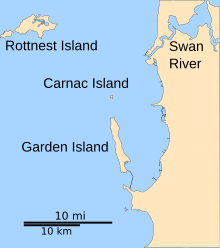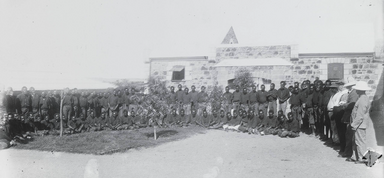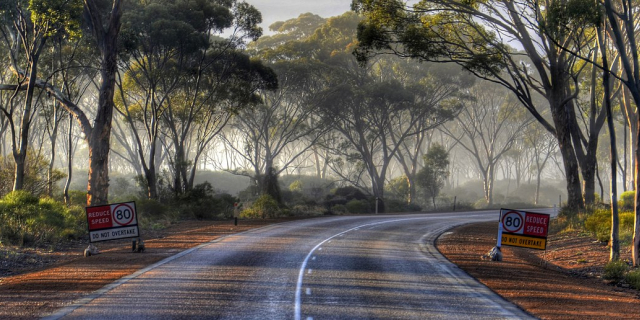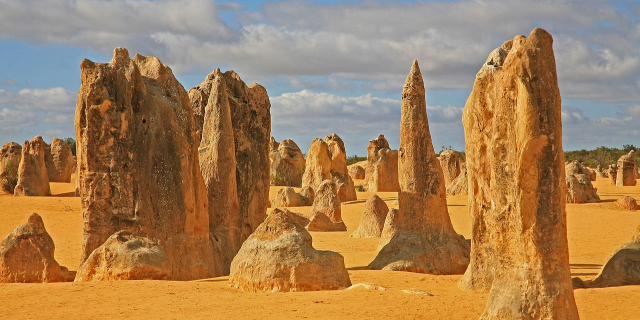Rottnest Island
Rottnest Island (Nyungar: Wadjemup), often colloquially referred to as "Rotto", is a 19-square-kilometre (7.3 sq mi) island off the coast of Western Australia, located 18 kilometres (11 mi) west of Fremantle. A sandy, low-lying island formed on a base of aeolianite limestone, Rottnest is an A-class reserve, the highest level of protection afforded to public land.
Together with Garden Island, Rottnest Island is a remnant of Pleistocene dune ridges. Along with several other islands, Rottnest became separated from the mainland around 7,000 years ago, when sea levels rose; the traditional Noongar name for the island is Wadjemup, which means "place across the water where the spirits are". Human artefacts have been found on the island dating back at least 30,000 years, but visitation and habitation of the island by the Noongar people appears to have ceased following its separation from the mainland.
The is...Read more
Rottnest Island (Nyungar: Wadjemup), often colloquially referred to as "Rotto", is a 19-square-kilometre (7.3 sq mi) island off the coast of Western Australia, located 18 kilometres (11 mi) west of Fremantle. A sandy, low-lying island formed on a base of aeolianite limestone, Rottnest is an A-class reserve, the highest level of protection afforded to public land.
Together with Garden Island, Rottnest Island is a remnant of Pleistocene dune ridges. Along with several other islands, Rottnest became separated from the mainland around 7,000 years ago, when sea levels rose; the traditional Noongar name for the island is Wadjemup, which means "place across the water where the spirits are". Human artefacts have been found on the island dating back at least 30,000 years, but visitation and habitation of the island by the Noongar people appears to have ceased following its separation from the mainland.
The island was first documented by Willem de Vlamingh in 1696, who called it 't Eylandt 't Rottenest ("Rats' Nest Island") after the quokka population. Following establishment of the Swan River Colony (now Perth) in 1829, the island was initially used by British settlers for agricultural purposes, and a permanent settlement was built in Thomson Bay. From 1838 to 1931, Rottnest Island was also used as a prison and forced labour camp for over 3,600 Aboriginal people, who were subjected to extremely harsh conditions on the island. Other historical uses of the island include as a military site, and for internment camps housing enemy aliens. Many of the island's buildings date from the colonial period, often made from locally quarried limestone, and are now used as accommodation for holidays.
Rottnest is an unincorporated area with no local government, subject to direct administration by the government of Western Australia. It is administered by the state's Rottnest Island Authority, which on 1 July 2017 became part of the newly created Department of Biodiversity, Conservation and Attractions. Rottnest is well known for its population of quokkas, and is also home to colonies of Australian sea lions and southern fur seals, as well as various birds and three native tree species, notably the Rottnest Island pine. The island is a popular recreational and tourist destination, with daily ferry services from Perth, the state's capital and largest city. It has a permanent population of around 300 people, with around 780,000 annual visitors.
The land that is now Rottnest Island was inhabited by Noongar people until rising sea levels separated it from the mainland of Western Australia about 7,000 years ago. The island features in Noongar story lines as Wadjemup.[1] Aboriginal artefacts on the island have been dated from 6,500 to more than 30,000 years ago.[2] However, other evidence suggests human occupation significantly before 50,000, possibly as early as 70,000 BP.[3]
No evidence has been found that the Whadjuk Noongar people continued to inhabit or visit the island after its separation from the mainland,[4] and by the time of European exploration in the 1600s, the island is thought to have been unoccupied for thousands of years.[5]
European exploration and settlementThe island was observed and explored by various Dutch, French, and English maritime expeditions from around 1619 onward, including by Frederick de Houtman around 28 July 1619.[6][7]
The first Europeans known to have landed on Rottnest Island were about 14 sailors from a Dutch expedition, including Abraham Leeman van Santwits from Waeckende Boey, who landed near Bathurst Point on 19 March 1658 while their ship was careened nearby.[8][9] Waeckende Boey (under command of Samuel Volkersen[a]) had been searching for survivors of Vergulde Draeck, which had been wrecked off the western coast of Australia in April 1656.[11][8][9]
 Location of Rottnest Island, Western Australia
Location of Rottnest Island, Western AustraliaVolkersen described the island in his journal:
In slightly under 32° S. Lat. there is a large island, at about 3 miles' distance from the mainland of the South-land; this island has high mountains, with a good deal of brushwood and many thornbushes, so that it is hard to go over; here certain animals are found, since we saw many excrements, and besides two seals and a wild cat, resembling a civet-cat, but with browner hair. This island is dangerous to touch at, owing to the rocky reefs which are level with the water and below the surface, almost along the whole length of the shore; between it and the mainland there are also numerous rocks and reefs, and slightly more to southward there is another small island.
This large island to which we have been unwilling to give a name, leaving this matter to the Honourable Lord Governor-General's pleasure, may be seen at 7 or 8 miles' distance out at sea in fine weather. I surmise that brackish or freshwater might be obtainable there, and likewise good firewood, but not without great trouble.[10]
In his 1681 chart, English captain John Daniel marked an island as Maiden's Isle, possibly referring to Rottnest. The name did not survive, however.[citation needed]
The island was given the name 't Eylandt 't Rottenest ("Rats' Nest Island"; the quokkas were mistaken for large rats[12]) by Dutch captain Willem de Vlamingh, who spent six days exploring the island from 29 December 1696. De Vlamingh led a fleet of three ships, De Geelvink, De Nijptang and Weseltje, searching for the survivors of Ridderschap van Holland that had gone missing two years earlier,[13] and anchored on the northern side of the island, near The Basin. He described the island as "...pleasurable above all islands I have ever seen -a paradise on earth".[14] During their time on the island, they found no people. Holes were dug on the island, yielding water of good drinking quality. They also noted that the wood from the trees on the island had an exquisite scent – akin to rosewood - and a quantity was cut and brought on board the ship.[15]
Other explorers who stopped at the island included members of the French expedition of Nicholas Baudin in Naturaliste and Geographe in 1801 (when he planted a flag and left a bottle with a letter)[16] and 1803, Phillip Parker King in 1822, and Captain James Stirling in 1827. Early visitors commonly reported that much of the island was heavily wooded, which is not the case today.[17]
In 1831, shortly after the establishment of the British Swan River Colony at nearby Fremantle, William Clarke and Robert Thomson received land grants for town lots and pasture land on the island. Thomson immediately moved to the island with his wife and eight children. He developed pasture land for hay production west of Herschel Lake as well as salt harvesting from the several salt lakes which was then exported to the mainland settlement. Salt was an important commodity before the advent of refrigeration.[citation needed]
Aboriginal prison and forced labour camp Aboriginal prisoners on the island in 1883
Aboriginal prisoners on the island in 1883Between 1838 and 1931, Aboriginal prisoners held on Rottnest Island were held in deplorable conditions and subjected to cruel and inhumane treatment. Of the approximately 3600 people imprisoned there, at least 373[18] people died and were buried in unmarked graves in at least two areas[19][20] to the north of the Quod. It is the largest known deaths in custody gravesite in Australia.[21][22]
Historical records note that the first cemetery, likely adjacent to the European cemetery, became full following an outbreak of influenza in 1883 and that a second was established further away from the prison. The area is now known as the Wadjemup Aboriginal Burial Ground. Although slavery, as legally defined, was never widespread in Western Australia (and, indeed, called blackbirding rather than plain slavery in the pearling industry), the "assignment" system effectively implemented a system of forced labour, and was condemned by Reverend J. B. Gribble and the Anti-Slavery Society. Aboriginal people who refused assignment were sent to Rottnest Island to be "civilised", and were used in chain-gangs to perform hard labour including farming, quarrying, and collecting salt.[23] Most of the island's historic Settlement – including Government House (Hotel Rottnest), the church, Salt Store, museum, gift shop, original waterfront cottages and The Quod – was built by forced Aboriginal prison labour working under extremely harsh conditions.[24]
Six Aboriginal prisoners were sent to Rottnest Island in August 1838 under the superintendence of Constable Laurence Welch and a small military force:[25] Helia, for murder; Buoyeen, for assault; Molly Dobbin, Tyoocan, Goodap, and Cogat, for theft.[26] All six escaped shortly after their arrival by stealing Thomson's boat. Helia drowned during the crossing, but the others apparently survived.
The Colonial Secretary, Peter Broun, announced in June 1839 that the island would be "converted to an Establishment for the Aborigines",[27] and between 1838 and 1931 (except for the period from 1849 to 1855) Rottnest was used as an Aboriginal prison. Henry Vincent, the Gaoler at Fremantle, was put in charge of the establishment.
On 7 December 1848, there was another escape by Aboriginal prisoners, with eight out of the 10 prisoners then on the island escaping. Those who escaped came from the north and eastward. "The plan of escape, as related by one of themselves, exhibits considerable foresight and sagacity, being not only well conceived, but as well executed". The Aboriginals burrowed under the sill door until there was room for them to all pass underneath. They all then crept over the roof of Vincent's kitchen and proceeded to the salt house, through the window of which they got out a dinghy which was confined there. They then went to the pilot's whaleboat moored a short distance offshore, and succeeded in getting to the mainland 16 kilometres (10 mi) north of Fremantle. Five of the escapees were retaken by J. Drummond at Toodyay.[28]
A quadrangular building was constructed in 1863–1864 and generally referred to as "the Quod"; it was used for tourist accommodation until 2018, when it was closed after decades of protests by Aboriginal people.[29] There were about twenty prisoners there in 1844; by 1880, there were 170. Vincent retired in 1867 after complaints regarding cruelty to prisoners; he was replaced by William Jackson. In the early 1880s, an influenza epidemic struck, killing about sixty inmates.
 Visitors to the "Quod", early 1900s
Visitors to the "Quod", early 1900sIn 1902, the abolition of the prison was announced. At that time, there were 33 Aboriginal prisoners serving sentences there.[30] However, the prison continued to be used as a forced labour camp for Aboriginal prisoners until 1931.[31][32]
Some 3,700 Aboriginal men and boys were imprisoned there during the life of the establishment.[33] There may be as many as 369 inmates' graves on the island; one writer has suggested that 95% of the deaths were from influenza.[34] In 2015 – after numerous protests from local Aboriginal people for the Rottnest Island Authority to create a memorial recognising the events, deaths, and unmarked graves which lie on Rottnest Island – work begun on the Wadjemup Aboriginal Burial Ground.
Artefacts from this period continue to be identified and recorded. Professor Len Collard describes these artefacts, such as glass and ceramic spearheads, as an important demonstration of transitional cultural engineering through use of traditional methods to modify the new materials of European settlement.[35]
ExecutionsFive Aboriginal prisoners were executed on Rottnest in the late 19th century, all for murder:
Tampin (16 July 1879): Hanged for the murder of John Moir at Stokes Inlet on 29 March 1877[36][37] Wangabiddi (18 June 1883): Hanged for the murder of Charles Redfern at Minni-Minni on the Gascoyne River in May 1882[38] Guerilla (18 June 1883): Hanged for the murder of Anthony Cornish at Fitzroy River on 12 December 1882[39] Naracorie (3 August 1883): Hanged for the murder of Charles Brackell at Wandagee on the Minilya River on 31 July 1882[40] Calabungamarra (13 June 1888): Hanged for the murder of a Chinese man, Indyco, at Hamersley Range[41]Wadjemup Aboriginal Burial GroundIn 2015 the restoration and recognition of the Wadjemup Aboriginal Burial Ground began.[42] As of June 2016[update] buildings have been removed from the site and pathway constructed around it.[43][44] Prior to the closure of the tourist camp in 2018, the burial ground was being using as a spot to pitch tents.[29][18]
Boys' reformatory The Quod buildings in 2021
The Quod buildings in 2021A reformatory for boys was opened on 16 May 1881.[45] The reformatory buildings were adjacent to the Quod and included a workshop, a kitchen, two large dormitories, a school room, and four small cells. Carpenter John Watson constructed the buildings and became the superintendent for the life of the establishment. Watson taught the boys carpentry, joinery, and gardening.[46][47]
During a severe influenza epidemic in 1883, the colonial surgeon, Dr Alfred R Waylen, directed one of the large rooms in the reformatory to be used as a hospital.[48] An estimate of sixty Indigenous deaths for that year was given by eye-witness, Edward Watson.[49] In 1887, the prison superintendent reported one room in the reformatory still being used for sick prisoners, with two rooms used the previous winter, and made an appeal for a new hospital to be built for the Indigenous prisoners.[50]
In May 1898, two boys disappeared, apparently drowned, after escaping from the reformatory and stealing a dinghy.[51]
After 20 years of operation, the facility closed on 21 September 1901 when the remaining 14 inmates were transferred to an industrial school on the mainland.
The reformatory buildings were used as holiday accommodation as part of the Rottnest Lodge[52] until 2022 when they were closed for redevelopment of more recently constructed parts of the site to create new accommodation and tourist facilities.
FiresIn 1856, the settlement structures – the two-storey prison / workshop building, stables, barns, and piggery were burnt down.[53] Their former locations are identified in the area between the shops in the settlement area. The fire was deliberately lit by the superintendent, Henry Vincent, after two prisoners had escaped into nearby bush.[54] Vincent lit the fire with the intent of flushing the prisoners out of their hiding place. The prevailing winds at the time were blowing away from the buildings; however, the wind changed direction which brought the flames into the settlement. About 50 tons of hay was also destroyed.
Major bushfires occurred in March 1894, January 1910, January 1917, March 1939, February 1949, and a very significant fire which consumed around two-thirds of the island in 1955.[55] Some of these bushfires were caused by European hunting parties and on one occasion almost wiped out the quokka population.
Pilot serviceIn 1846, a pilot service was established under Captain Edward Back. It continued for 56 years until 1903.[56] The pilot's and crews quarters were located in at least three of the colonial buildings identified in the colonial buildings of Rottnest Island — buildings 4, 5, and 6.
Internment campRottnest was the site of internment camps in both World War I and World War II[57] In World War I, it was mostly used for German and Austrian suspected enemy aliens, and was closed towards the end of the war, due to poor living conditions. The camp was sited near the present-day Caroline Thomson Camping Area.
In World War II, the camp was used exclusively for Italian enemy aliens and was situated near the airstrip.[58] It had capacity for 120 internees.
It was closed about halfway through the war, and its occupants were sent to various other internment and work camps on the mainland.[59]
Military history BL 9.2 inch Mk X gun at Oliver Hill
BL 9.2 inch Mk X gun at Oliver HillAlso during World War II, two 9.2 inch guns were installed near the middle of the island at Oliver Hill, and two 6 inch guns installed at Bickley Point,[60] for defence of the Fremantle port. The location of the island was seen as being important to the defense of the important port of Fremantle, the major base for the Allies in the Indian Ocean, as bombardment of any attacking ships could be made from the island before the ships would come into range of the port.
A light railway was built from the jetty at Kingstown Barracks on Thomson Bay, to transport materiel and munitions to the guns. Captain (later Brigadier) Frank Bertram Hussey (1908–1985) was seconded from the Australian Staff Corps[61] to oversee the construction of this.[62] The military fixtures including the barracks and railway became known as the "Rottnest Island Fortress". A number of concrete lookouts and bunkers were built around the island also.
Near Wadjemup Lighthouse, a Battery Observation Post (BOP) was built as a lookout to coordinate aiming and firings from the Bickley and Oliver Hill Batteries. A Signals Building, associated with the BOP and a Women's Army Barracks, built to house officers and staff who operated the BOP were constructed there also. The latter building is used nowadays for occasional accommodation for University and other scientific research groups working on the island.
After World War II, the guns and infrastructure were decommissioned and parts of the railway removed. The 9.2 inch battery, however, was saved from disposal because the high cost of removing and shipping the guns to the mainland exceeded their value as scrap metal.
In the 1990s, the gun emplacements and railway were extensively reconstructed, and since then a popular tourist activity has included a tour of the guns and the tunnels, with the journey to the battery being made on a purpose-built train from Kingstown Barracks. In November 2003 a new railcar was put into service for this route, called the Captain Hussey (named after Brigadier Hussey; see above). The railcar was built with volunteer assistance, and cost $171,500.[63]
Communications Ruins of the 1907 fog signal
Ruins of the 1907 fog signalPrior to about 1880, communication with the mainland was primarily with semaphore flags and flares.[64] A staffed lookout at Bathurst Point included a signalling station which relayed shipping information between Wadjemup Lighthouse at the centre of the island and Arthur Head at Fremantle.
A heliograph was installed in 1879 at Signal Hill, the small rise overlooking the main settlement in Thomson Bay. A Frenchman by the name of Henri Courderot was the heliograph operator and was paid $10 per year to operate the service once a day weather permitting.
A single circuit submarine communications cable was laid from Cottesloe in 1900, after which the heliograph service was discontinued.[64] This was replaced with a larger cable in 1935.
AdministrationAfter Rottnest was proclaimed as an A-class Reserve in 1917, management was vested in the "Rottnest Island Board of Control" which continued until 1956. The first chairman was Hal Colebatch, who served from 13 May 1917 to 23 July 1956. Rottnest Island was declared an A class reserve under the Permanent Reserves Act in May 1917. A Board was then appointed under the Parks and Reserves Act to control and manage the island (excluding the lighthouse and prison reserve). The Board of Control became a Body Corporate in 1956 and became a Board of Management.[65][66]
Between 24 July 1956 and 29 May 1988, it was changed to the "Board of Management". Section 3, subsection 4 of the Parks and Reserves Act 1895–1955 provided legislative scope for the Rottnest Island Board of Control became a Body Corporate on 24 July 1956. The Rottnest Island Board of Control became the Rottnest Island Board of Management "with power to sue and be sued in its corporate name, to acquire, hold, lease and dispose of real and personal property, to borrow money with the approval of the Governor and to do and permit to be done all things which are required by the Act to the be done by the Board ...", until 1988 at which time it became the Rottnest Island Authority.[67] During this time the managing instrumentality was informally and generally referred to as the "Rottnest Island Board" (RIB). In 1988 the "Rottnest Island Authority" commenced operations.
In May 1966, Rottnest Island and Carnac Island were included in the boundaries of the Shire of Cockburn, which became the City of Cockburn in 1971. However, the council has "no involvement in or responsibility for any functions relating to the control and management of the islands".[68]
On 28 April 2017, the government of Western Australia announced that the Department of Parks and Wildlife would merge with the Botanic Gardens and Parks Authority, the Zoological Parks Authority, and the Rottnest Island Authority on 1 July 2017 to form the Department of Biodiversity, Conservation and Attractions.[69]
Uniquely for Western Australia, the island is classified as a state reserve, the Rottnest Island State Reserve, being the only area in the state with this classification. The reserve extends beyond the island's shore and covers 5,669 hectares (14,010 acres).[70][71]
COVID-19 pandemicBetween March and May 2020, during the COVID-19 pandemic in Australia, the island was used as a quarantine station for arriving tourists and returning Australians.[72][73]
Cite error: There are <ref group=lower-alpha> tags or {{efn}} templates on this page, but the references will not show without a {{reflist|group=lower-alpha}} template or {{notelist}} template (see the help page).






















Add new comment